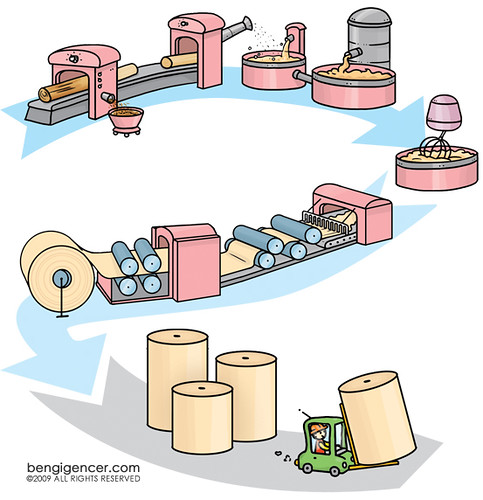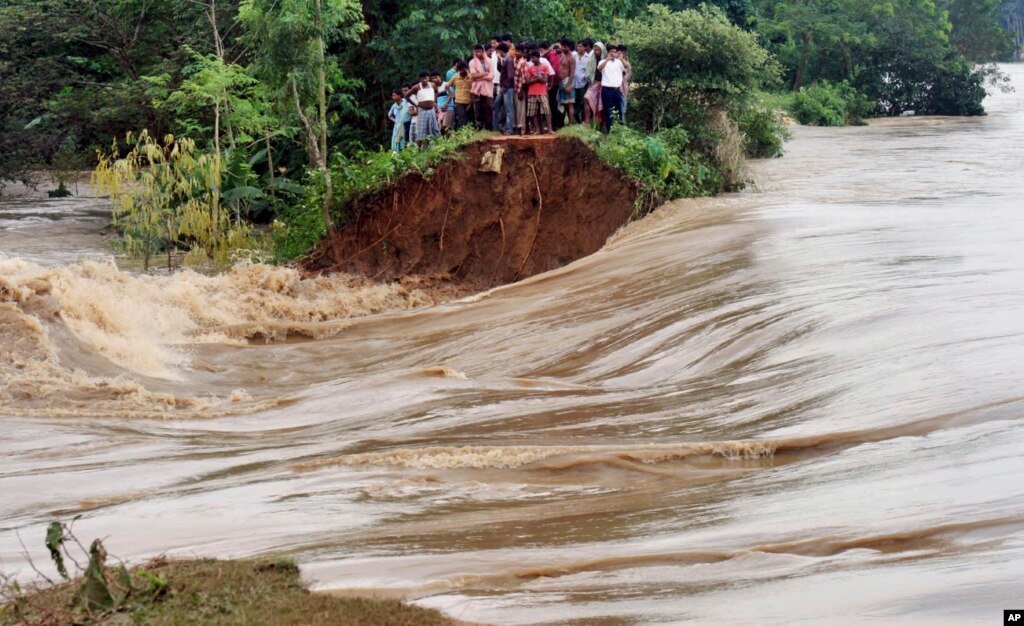A few weeks ago I found myself in a very strange conversation with a co-worker about the paper production process. Long story short, this gentleman explained to me how making paper from trees was one of the worst ideas of the industrial age. His point was that the process of extracting wood by way of destroying trees is a terribly inefficient use of resources given how ubiquitous and disposable paper needs to be. In other words, chopping down trees, grinding them up, turning them into mush and then spinning this mush into dry paper incurs many more costs than is necessary -- air quality, wildlife habitat, energy usage in the process, dedicated transport and required infrastructure. This is especially so since paper is needed in such large amounts (despite technology creating a paper-less world), and the associated necessity of it all being of low cost to the consumer. For those that may not be in the know, below is a simple diagram explaining the paper process, minus the first step -- cutting down a lot of trees.
 |
| I love good diagrams, and this is the cleanest and simplest one I could find. Kuda Bengi Gencer (courtesy of a Google Image Search and Flickr page I could not access) |
If you were to ask me, I would like to think that I have a pretty conscious and deliberate ethical focus on living sustainably and the conservation of natural resources. However, this is the very first time I have ever thought to question whether or not it makes sense to use trees to make paper. After some discussion and a few hours of reading I have to say I agree with my coworker. Using wood for paper doesn't make much sense outside of it being of historic industry similar to coal power or corn syrup. I don't think wood is an efficient resource for making paper. Agriculture, building materials, and land-clearing for certain types of development all seem like much more substantial societal moves and thus, I think, are more worth while causes for destroying the acres of forestry necessary compared to simply making paper. And such was the gist of the conversation. How about that.
Coincidentally enough, a few days later I was picking up some supplied from the local stationery store and in the notebooks aisle found this:
 |
| The store only has A5 in both flip-top and normal side bound varieties, and the tiny pocket sized sets. There are no full A4 or letter sized products, though they do exist online. |
On the lower shelves there had these "Nu:World" branded "Tough Paper" books available in various sizes. I was immediately drawn by the very tradesmen (which I am not) inspired design so I picked it up to have a look. How could a notebook be especially made to be tougher? Water, oil and tear resistant? How? Paper made from stone? What?
 |
| Nu: World Stone Paper |
Above you can see the information page which bullets through the main features of
Nu World Stone Paper.
Here is a link to Nuco-International website for the full breakdown. In short, this is a notebook with special paper. The paper isn't made from wood, but instead, a combination of ground limestone and polyethylene (a type of plastic). Because of this, the main benefits are:
- 100% water proof
- Tear resistant
- Tree Free
- Less energy consumptive
- Recyclable
- Water is not needed in production
- Feels awesome.
Overall, as weird as it is to talk so highly, and so much, about paper, I have to say that all of this is very true. It feels really smooth to write with. Pens glide across the pages as oppose to scratch and there's much less chance of indentation. The need for less pressure is quite obvious, so those with a tendency to press hard with their pens may actually feel the paper is too soft.
Stone paper is definitely much more difficult to tear. You can see the paper stretch (like plastic) before it actually tears, and when when it does it's more of split than a tear. I don't imagine frayed edges or accidentally ripped corners would be a problem here.
The most impressive characteristic for me is that it actually is water proof. I would be lying if I said I wasn't excited to test this feature and am happy to say it's true. I was able to wipe the paper clean and write immediately after. The paper wasn't soaked through at all. I don't think I've ever found myself writing in wet conditions, so it's not really applicable to my life, but it's still pretty handy. Realistically I could imagine plenty of workers that have to take write notes in wet environments and how frustrating that might be. Below are a few photos of my experiment.
 |
| If this happened by accident when I was actually working, I, like most anyone, would be fairly upset. |
 |
| Obviously, you can't forget that the ink isn't waterproof. |
Again, I know it's just paper, but I've found myself talking about this product for weeks. I'm just so fascinated by the concept. That being said, discussion has lead to a decent amount of reservation regarding the "environmentally friendly" side of the marketing campaign Nuco is pushing. For the record, Nuco seems to be focused on notebooks and papers of various uses and sorts. There are leather bound professional notebooks and bright-coloured variations geared to younger students, all with normal paper. Stone paper is just one of these products, so it is not as if Nuco has a specific environmental focus behind their business model. In any case, With any new product or idea, especially one which claims to be a solution to serious large scale problems (like the environment), it's important to do the due diligence and examine all aspects of the issue.
First, limestone comes from mines, and mining does a terrible amount of damage to a lot of things. The danger it puts the workers in aside, mining is as responsible for habitat loss and air pollution as anything can be. Now, the "calcium carbonate-chalk" stone paper is made from may be "the world's 4th most plentiful material" (if my understanding of science is accurate, silicon, aluminium and iron are the top 3), but it's still a product of mining which means natural materials are being dug up and ripped out of the ground in gigantic amounts. To it's benefit, the limestone is taken as a by-product from quarries, which means mines aren't specifically opened for it, but it's taken from the pile of refuse. Either way, I'm sure you would have a hard time finding someone specialising in environmental conservation happy with anything having to do with mining.
Also, it's made from plastic and although plastic can be treated to be made biodegradable, it doesn't really break down by nature. What this means is that waste which is not recycled build up more than regular paper would, and what to do with high deposits of non-degradable plastic waste is another issue altogether. I have tried burning it. It burns similar to normal paper but a bit more slowly and with less smoke. I still needed to run it under the tap to stop it. I'm not sure why this is relevant, I suppose I was hoping it would melt and change shape like a plastic grocery bag. Oh well. This is why there is no photo. I don't think a burnt corner of a piece of paper would be that interesting.
 |
| I wouldn't mind a different, non-tradie design. I can't say I'm a fan. I am currently deciding if a care enough to customise this with some fabric or paint. |
At the end of the day, paper made from stone seems like it's the real deal. I definitely love the material and have told anyone whenever the opportunity arose. The reality is that although it may not be the solution mother Earth has been waiting for, it absolutely has it's benefits. No trees will be killed for it's sake and plenty of water and electricity will be saved, yet landfills may be at further risk. Either way, given these books fit well within the market standards for notebooks (definitely not the cheapest at $4 per, but much more affordable than premium leather-bound varieties), I'm a definite fan. At the very least, it will give you some pretty interesting, albeit very nerdy, conversations to have about the environment, technology and industrial creativity.




